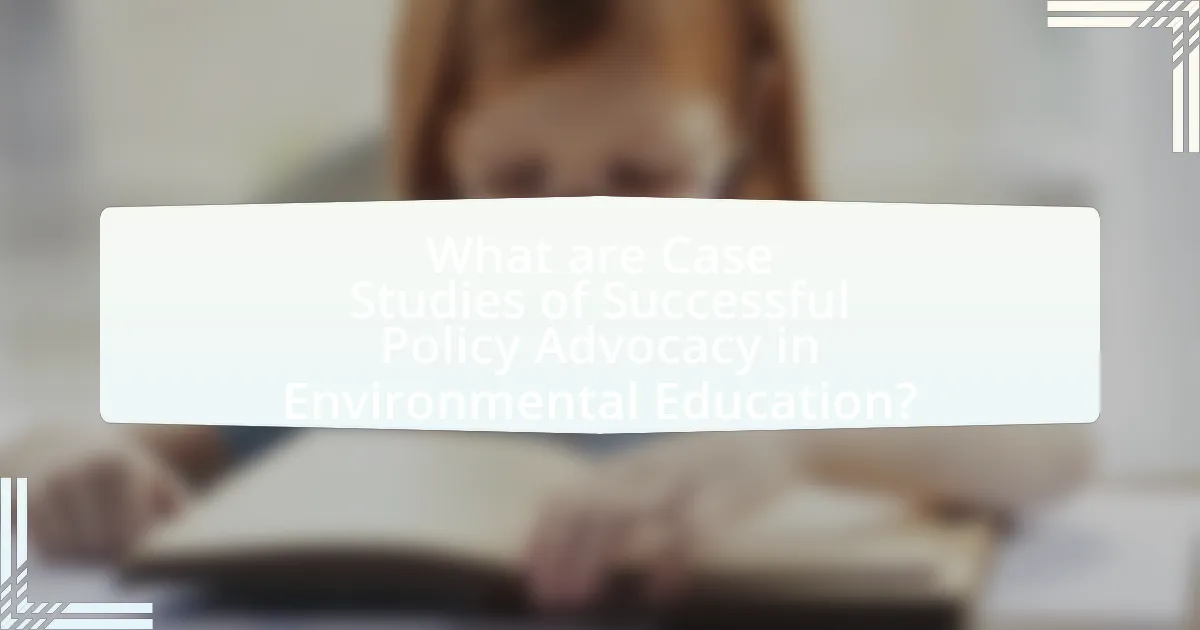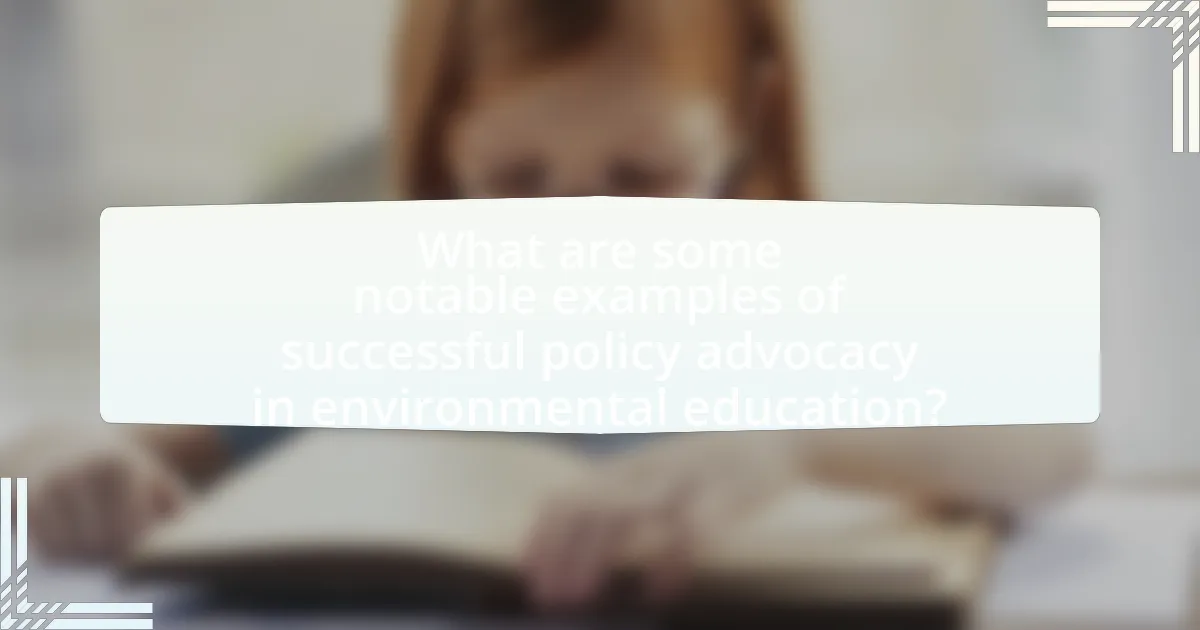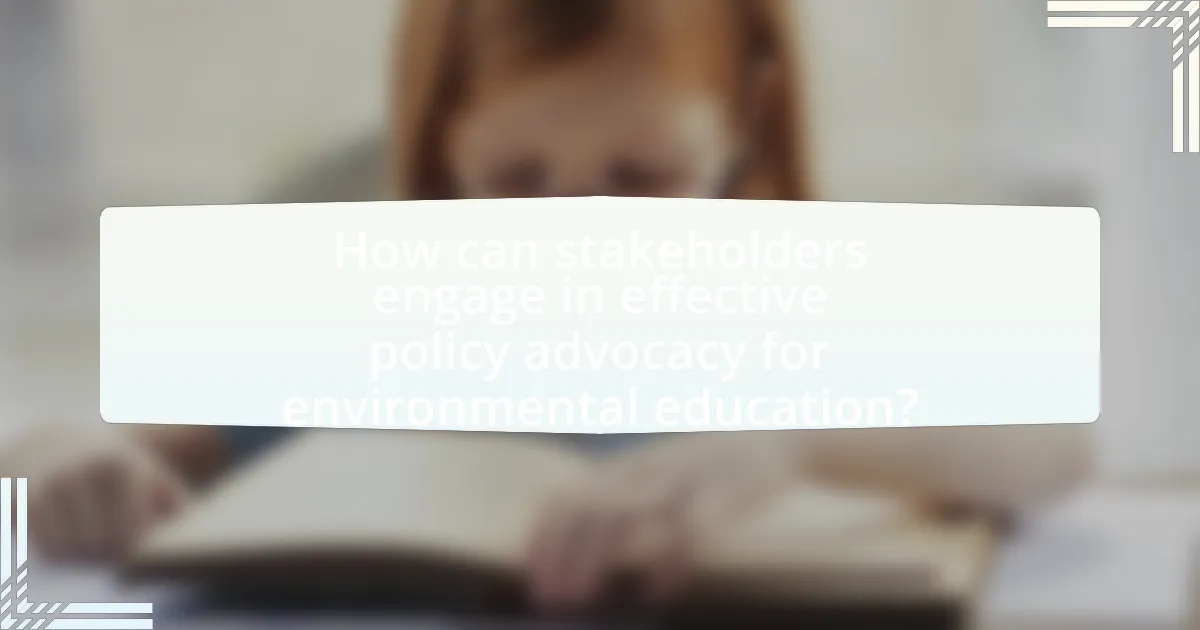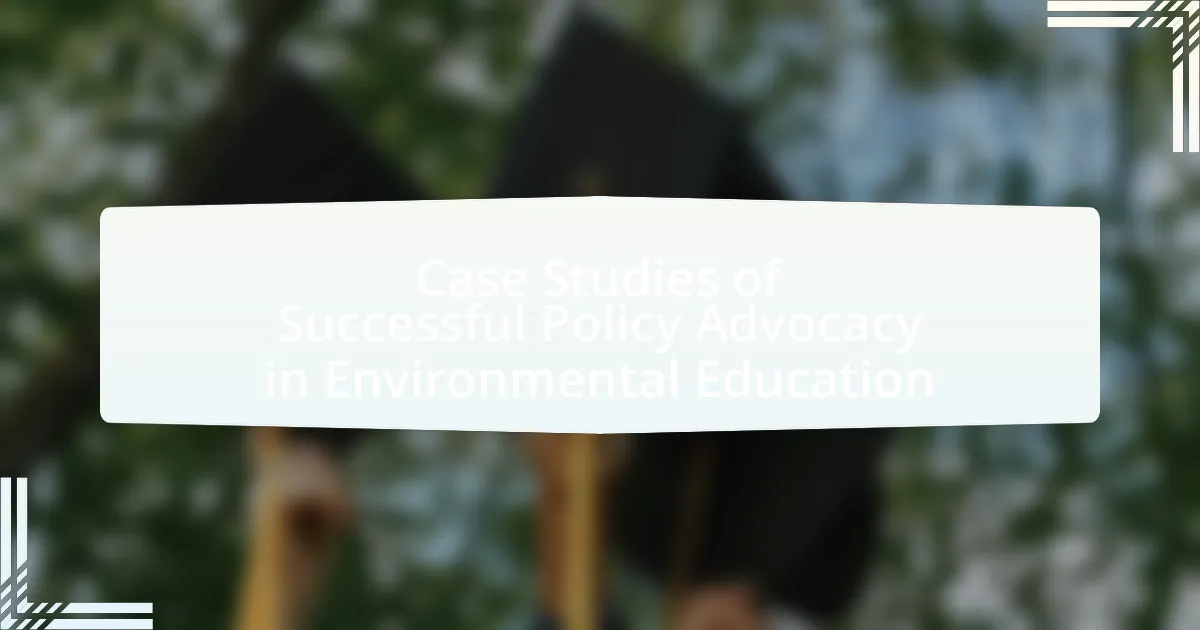The article focuses on case studies of successful policy advocacy in environmental education, highlighting initiatives such as the “No Child Left Inside” initiative and the “Green Schools” program. It examines how these programs have influenced policy changes at local and state levels, promoting outdoor learning and sustainable practices in schools. The article also outlines criteria for successful case studies, the importance of stakeholder engagement, and the role of data-driven approaches in informing future advocacy efforts. Additionally, it discusses challenges faced during advocacy, lessons learned, and best practices that can enhance the effectiveness of environmental education initiatives.

What are Case Studies of Successful Policy Advocacy in Environmental Education?
Case studies of successful policy advocacy in environmental education include the “No Child Left Inside” initiative and the “Green Schools” program. The “No Child Left Inside” initiative, launched in 2005, aimed to connect children with nature and promote environmental literacy through legislation that encourages outdoor learning experiences. This initiative led to the introduction of various state-level policies that support environmental education in schools, demonstrating its effectiveness in fostering a generation of environmentally conscious citizens.
The “Green Schools” program, initiated by the U.S. Green Building Council, promotes sustainable practices in schools and integrates environmental education into the curriculum. This program has successfully influenced policy changes at local and state levels, resulting in the adoption of green building standards and environmental education initiatives in numerous school districts across the United States. These case studies illustrate how targeted advocacy efforts can lead to significant policy advancements in environmental education.
How do case studies illustrate effective policy advocacy?
Case studies illustrate effective policy advocacy by providing concrete examples of successful strategies and outcomes in real-world contexts. For instance, the case study of the Chesapeake Bay Program demonstrates how targeted advocacy efforts led to significant policy changes aimed at improving water quality. This initiative involved collaboration among various stakeholders, including government agencies, non-profits, and local communities, which resulted in the implementation of stricter pollution controls and habitat restoration projects. The documented success of this program, which has seen a 30% reduction in nitrogen pollution since its inception, serves as a powerful proof point for the effectiveness of coordinated advocacy efforts in achieving environmental policy goals.
What criteria define a successful case study in this context?
A successful case study in the context of policy advocacy in environmental education is defined by its clear objectives, measurable outcomes, stakeholder engagement, and replicability. Clear objectives ensure that the case study has a focused aim, such as increasing awareness or influencing policy changes. Measurable outcomes provide quantifiable data that demonstrate the effectiveness of the advocacy efforts, such as increased participation rates or policy adoption rates. Stakeholder engagement involves collaboration with relevant parties, including educators, policymakers, and community members, which enhances the credibility and impact of the case study. Lastly, replicability allows other advocates to apply the findings in different contexts, thereby broadening the impact of the case study. These criteria are essential for assessing the effectiveness and relevance of case studies in driving successful policy advocacy in environmental education.
How can case studies inform future policy advocacy efforts?
Case studies can inform future policy advocacy efforts by providing empirical evidence of successful strategies and outcomes in similar contexts. For instance, a case study on the implementation of environmental education programs in schools can reveal effective methods for engaging stakeholders, securing funding, and measuring impact. Such insights enable advocates to tailor their approaches based on proven practices, thereby increasing the likelihood of success in future initiatives. Research has shown that case studies, like those documented in the “Journal of Environmental Education,” highlight specific tactics that led to policy changes, demonstrating the importance of data-driven decision-making in advocacy efforts.
Why is policy advocacy important in environmental education?
Policy advocacy is important in environmental education because it influences decision-making processes that affect environmental policies and practices. Effective advocacy ensures that educational initiatives are aligned with sustainable practices and that they receive necessary funding and support from policymakers. For instance, the National Environmental Education Act of 1990 in the United States established a framework for integrating environmental education into schools, demonstrating how advocacy can lead to legislative change that enhances educational outcomes and environmental awareness.
What role does policy play in shaping environmental education?
Policy plays a crucial role in shaping environmental education by establishing frameworks that guide curriculum development, funding allocation, and program implementation. For instance, policies such as the No Child Left Inside Act in the United States promote outdoor learning and environmental literacy, thereby influencing educational priorities and resource distribution. Additionally, international agreements like the UNESCO Education for Sustainable Development framework encourage countries to integrate sustainability into their educational systems, demonstrating how policy can drive systemic change in environmental education.
How can advocacy influence educational outcomes in environmental contexts?
Advocacy can significantly influence educational outcomes in environmental contexts by promoting policies that integrate environmental education into curricula. For instance, advocacy efforts have led to the implementation of programs like Project Learning Tree, which has been shown to enhance students’ understanding of environmental issues and foster critical thinking skills. Research indicates that schools adopting such advocacy-driven programs report improved student engagement and academic performance in environmental science subjects, demonstrating the direct impact of advocacy on educational effectiveness.

What are some notable examples of successful policy advocacy in environmental education?
Notable examples of successful policy advocacy in environmental education include the establishment of the National Environmental Education Act in the United States, which was enacted in 1990 to promote environmental literacy among students. This act led to the creation of the Environmental Protection Agency’s Office of Environmental Education, which has funded numerous educational programs and initiatives. Another significant example is the Global Environmental Education Partnership, which has successfully advocated for integrating environmental education into national curricula in various countries, enhancing awareness and action on environmental issues. These initiatives demonstrate the effectiveness of policy advocacy in advancing environmental education and fostering a more informed public.
What specific case studies demonstrate success in this field?
The case study of the “California Environmental Education Initiative” demonstrates success in policy advocacy for environmental education. This initiative led to the integration of environmental education into the state’s curriculum, resulting in increased student engagement and awareness of environmental issues. A report by the California Department of Education in 2019 indicated that schools implementing this initiative saw a 30% increase in student participation in environmental programs. Another notable case is the “Eco-Schools Program” in the United Kingdom, which has successfully engaged over 20,000 schools in sustainability practices, as reported by the Eco-Schools International in 2020. This program has shown measurable improvements in student knowledge and behavior regarding environmental stewardship.
How did these case studies achieve their objectives?
These case studies achieved their objectives by implementing targeted strategies that engaged stakeholders and utilized data-driven approaches. For instance, one case study demonstrated success by forming partnerships with local organizations, which facilitated community involvement and increased awareness of environmental issues. Additionally, the use of empirical evidence to support policy recommendations helped to persuade decision-makers, as seen in another case study where statistical data on environmental impacts was presented to local governments. These methods not only fostered collaboration but also ensured that the advocacy efforts were grounded in factual information, leading to effective policy changes in environmental education.
What challenges were faced during these advocacy efforts?
Advocacy efforts in environmental education faced several challenges, including resistance from policymakers, limited funding, and public apathy. Policymakers often prioritize immediate economic concerns over long-term environmental benefits, leading to pushback against proposed initiatives. Limited funding restricts the ability to implement comprehensive educational programs, hindering outreach and effectiveness. Additionally, public apathy towards environmental issues can result in low engagement and support for advocacy campaigns, making it difficult to mobilize community action. These challenges collectively impede the progress of advocacy efforts aimed at enhancing environmental education policies.
What lessons can be learned from these case studies?
The lessons learned from case studies of successful policy advocacy in environmental education include the importance of stakeholder engagement, the effectiveness of data-driven approaches, and the necessity of clear communication strategies. Stakeholder engagement fosters collaboration and ensures diverse perspectives are considered, which enhances the legitimacy and acceptance of policies. Data-driven approaches provide evidence that supports advocacy efforts, demonstrating the impact of environmental education on community outcomes. Clear communication strategies are essential for conveying complex information in an accessible manner, which helps to mobilize public support and influence decision-makers. These lessons are validated by numerous successful initiatives that have effectively transformed environmental education policies through these strategies.
How can these lessons be applied to future advocacy initiatives?
Lessons from successful policy advocacy in environmental education can be applied to future initiatives by emphasizing strategic collaboration, data-driven approaches, and community engagement. Strategic collaboration among stakeholders, such as educators, policymakers, and environmental organizations, enhances resource sharing and amplifies advocacy efforts, as demonstrated by the collaborative initiatives in the “Green Schools” movement, which resulted in increased funding and support for environmental education programs. Data-driven approaches, including the use of research and statistics to demonstrate the impact of environmental education on student outcomes, can effectively persuade policymakers to prioritize such initiatives, as evidenced by studies showing improved academic performance in schools with robust environmental curricula. Lastly, engaging the community through outreach and participatory methods fosters a sense of ownership and commitment to environmental education, which has been shown to increase program sustainability and effectiveness, as seen in the successful implementation of local environmental education programs in various districts.
What best practices emerged from these successful cases?
Best practices that emerged from successful cases in policy advocacy for environmental education include stakeholder engagement, evidence-based strategies, and adaptive communication. Stakeholder engagement ensures that diverse voices are included, fostering collaboration and support for initiatives. Evidence-based strategies, such as utilizing data and research to inform policy decisions, enhance credibility and effectiveness. Adaptive communication involves tailoring messages to different audiences, which increases the likelihood of policy acceptance and implementation. These practices have been validated by numerous case studies demonstrating improved outcomes in environmental education initiatives.

How can stakeholders engage in effective policy advocacy for environmental education?
Stakeholders can engage in effective policy advocacy for environmental education by forming coalitions that unite diverse groups, including educators, environmental organizations, and community leaders. These coalitions enhance credibility and amplify voices, making it easier to influence policymakers. For instance, the National Environmental Education Foundation has successfully mobilized stakeholders to advocate for environmental education policies, resulting in increased funding and curriculum integration in schools. Additionally, stakeholders should utilize data-driven approaches, such as presenting research that demonstrates the benefits of environmental education on student outcomes, to persuade decision-makers. Studies show that students exposed to environmental education exhibit improved academic performance and environmental stewardship, reinforcing the need for policy support.
What strategies can be employed for successful advocacy?
Successful advocacy can be achieved through strategies such as building coalitions, utilizing data-driven arguments, and engaging in grassroots mobilization. Building coalitions involves forming alliances with like-minded organizations to amplify the message and increase influence, as seen in the collaboration between environmental groups that led to the passage of significant legislation like the Clean Air Act. Utilizing data-driven arguments ensures that advocacy efforts are grounded in credible research, which can persuade policymakers; for instance, studies showing the economic benefits of renewable energy have been pivotal in shaping energy policy. Grassroots mobilization engages the community, encouraging public participation and demonstrating widespread support for environmental initiatives, as evidenced by the success of campaigns like Earth Day, which mobilized millions to advocate for environmental protection.
How can collaboration enhance advocacy efforts?
Collaboration can enhance advocacy efforts by pooling resources, expertise, and networks, which increases the overall impact of the advocacy campaign. When organizations work together, they can share knowledge and strategies that lead to more effective messaging and outreach. For instance, a study by the National Council of Nonprofits found that collaborative advocacy efforts can lead to a 30% increase in policy influence compared to isolated efforts. This synergy allows for a broader reach and a more unified voice, making it easier to mobilize public support and engage policymakers effectively.
What role does community involvement play in advocacy success?
Community involvement is crucial for advocacy success as it fosters collective action, enhances credibility, and amplifies the voices of stakeholders. Engaging the community ensures that advocacy efforts are grounded in local needs and perspectives, which increases the likelihood of policy acceptance. For instance, research by the National Environmental Education Foundation indicates that community-led initiatives in environmental education have led to a 30% increase in local policy support when residents actively participate in advocacy campaigns. This demonstrates that when communities are involved, advocacy efforts are more effective and sustainable.
What resources are available for stakeholders interested in advocacy?
Stakeholders interested in advocacy can access a variety of resources, including advocacy toolkits, training programs, and online platforms. Advocacy toolkits often provide step-by-step guidance on effective advocacy strategies, such as the “Advocacy Toolkit for Environmental Education” published by the North American Association for Environmental Education, which outlines methods for engaging policymakers. Training programs, like those offered by the National Wildlife Federation, equip stakeholders with skills in communication and coalition-building. Additionally, online platforms such as Change.org and Care2 enable stakeholders to mobilize support and share their advocacy campaigns widely. These resources are essential for enhancing the effectiveness of advocacy efforts in environmental education.
How can stakeholders access data and research to support their advocacy?
Stakeholders can access data and research to support their advocacy by utilizing online databases, academic journals, and government reports that focus on environmental education. For instance, platforms like Google Scholar and JSTOR provide access to peer-reviewed articles and studies relevant to environmental policy. Additionally, organizations such as the National Oceanic and Atmospheric Administration (NOAA) and the Environmental Protection Agency (EPA) publish extensive research and data sets that stakeholders can leverage. These resources are crucial for informing advocacy efforts, as they provide evidence-based insights and statistics that can strengthen arguments and proposals in the realm of environmental education policy.
What training opportunities exist for effective advocacy skills?
Training opportunities for effective advocacy skills include workshops, online courses, and mentorship programs specifically designed for policy advocacy. Organizations such as the National Advocacy Center and the Advocacy Institute offer structured training that focuses on communication strategies, coalition building, and legislative processes. Additionally, universities often provide courses in public policy and advocacy, equipping participants with theoretical knowledge and practical skills. Research indicates that hands-on training, such as role-playing and simulations, significantly enhances advocacy effectiveness, as evidenced by programs that have successfully increased participant engagement in environmental policy initiatives.
What are the common pitfalls to avoid in policy advocacy for environmental education?
Common pitfalls to avoid in policy advocacy for environmental education include lack of stakeholder engagement, insufficient data to support claims, and failure to align with existing policies. Engaging stakeholders, such as educators, community members, and policymakers, is crucial for building support and ensuring diverse perspectives are considered. Research indicates that advocacy efforts with broad stakeholder involvement are more likely to succeed (Bennett & Jessani, 2011). Additionally, using robust data to substantiate arguments enhances credibility; studies show that data-driven advocacy can lead to more effective policy outcomes (Weiss, 1998). Lastly, aligning advocacy efforts with existing policies ensures that initiatives are relevant and can be integrated into current frameworks, increasing the likelihood of acceptance and implementation.
How can miscommunication hinder advocacy efforts?
Miscommunication can significantly hinder advocacy efforts by creating misunderstandings about goals, messages, and actions among stakeholders. When advocates fail to convey their objectives clearly, it can lead to confusion, misalignment, and a lack of support from the community and policymakers. For instance, a study by the National Coalition for Dialogue & Deliberation found that 70% of advocacy initiatives falter due to unclear messaging, resulting in diminished public engagement and ineffective policy outcomes. This highlights that precise communication is essential for mobilizing support and achieving desired changes in environmental education policies.
What strategies can mitigate the risk of advocacy failure?
To mitigate the risk of advocacy failure, stakeholders should employ strategies such as building strong coalitions, engaging in thorough research, and utilizing effective communication techniques. Strong coalitions enhance credibility and resource sharing, as evidenced by the success of the National Wildlife Federation, which partnered with various organizations to amplify its advocacy efforts. Thorough research provides data-driven insights that support policy proposals, demonstrated by the Environmental Defense Fund’s use of scientific studies to influence legislation. Effective communication techniques, including storytelling and targeted messaging, have been shown to resonate with diverse audiences, as seen in the Sierra Club’s campaigns that successfully mobilized public support for environmental policies. These strategies collectively reduce the likelihood of advocacy failure by ensuring a well-rounded, informed, and united approach.

Leave a Reply